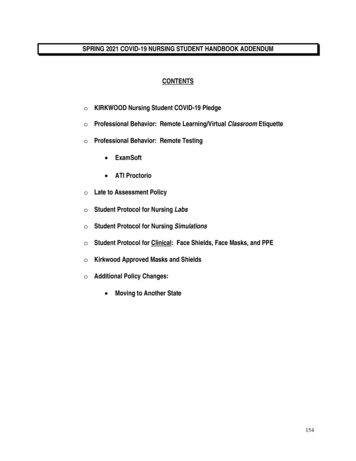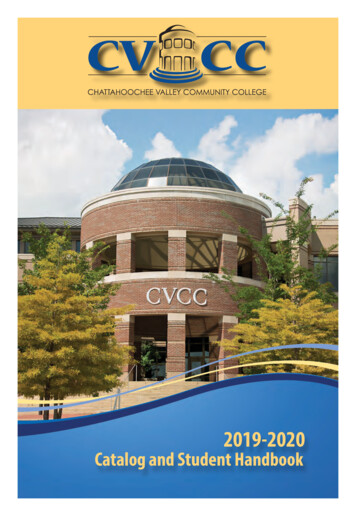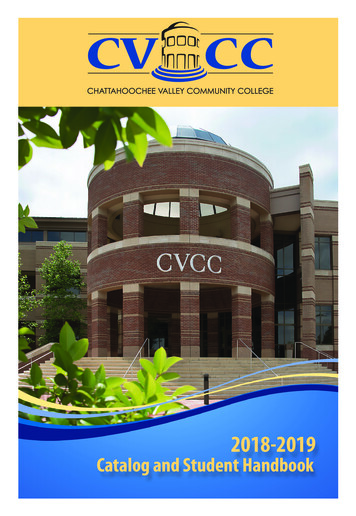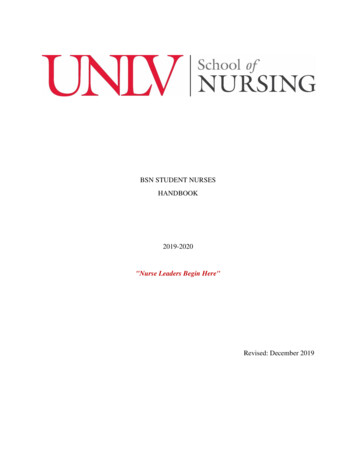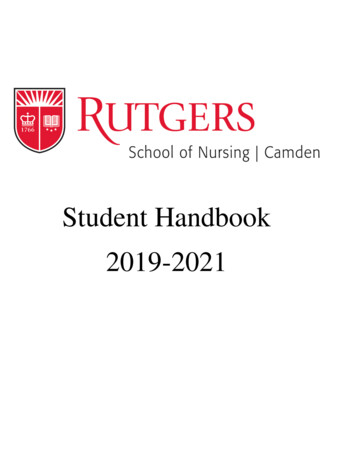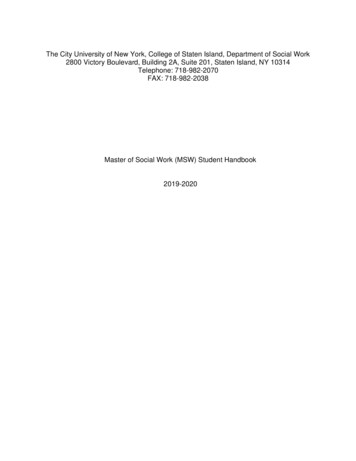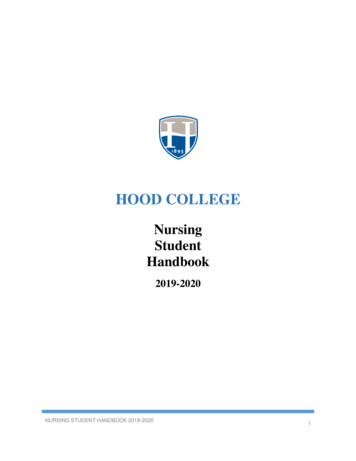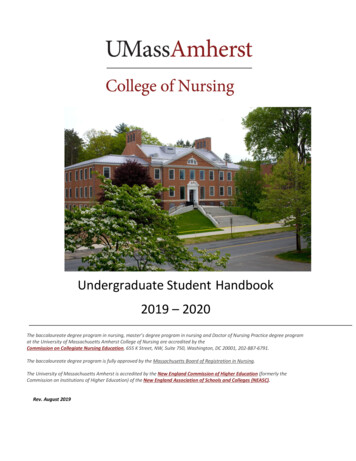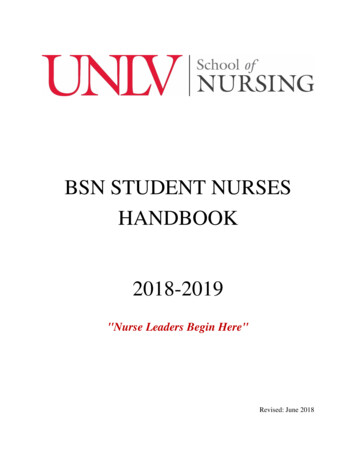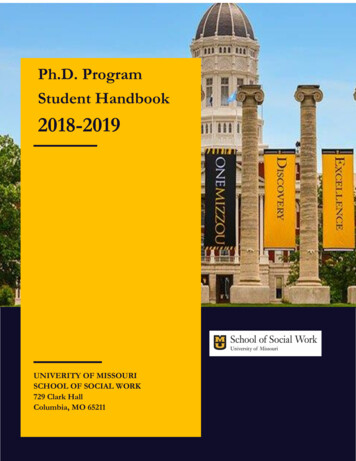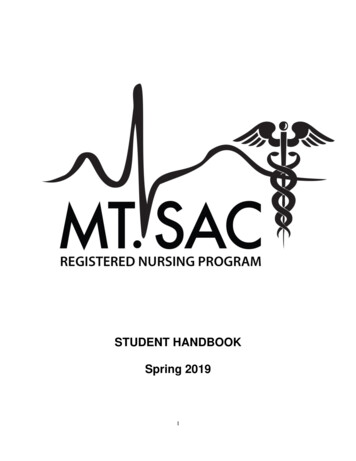
Transcription
STUDENT HANDBOOKSpring 20191
Student Handbook Procedures and PoliciesTable of Contents5Introduction6Non-Discrimination Policy Statement6Department of Nursing Mission Statement7Department of Nursing Philosophy7Program Objectives9Curriculum Tracks/Options15Organizational Chart16161616Progress in the ProgramCollege RequirementsCourse RequirementsMedication Calculation Competency1717Transfer/Advanced Placement StudentsCredit Granting Policy17Challenge/Advanced Placement Into the Nursing Education Program forMilitary Personnel19Challenge Procedures2020202021Student Assistance ProgramsFinancial AssistanceScholarshipsChild CareACCESS Student Programs & Services2121212122Student Academic ResourcesLearning Assistance CenterTech Ed Resource Center (TERC)Health Careers Resource Center (HCRC)CPR Center2323Student ParticipationStudent Class Representatives (SCR)2
24CNSA – California Nursing Student Association24Student of Distinction Awards25Other Campus Organizations25252627272929Curriculum GuidelinesMethod of InstructionsMethod of Testing/Grading/EvaluationCondition/Requirements of the CourseLaboratory/Clinical EvaluationUnsatisfactory ProgressCourse Program Evaluation2930Written Assignments and Tests PoliciesAPA Style313131313132General Policies Relating to Students in the Nursing ProgramCommunicationRelease of InformationChange of AddressClassroom RulesConfidentiality and Clinical PoliciesEligibility VerificationEssential Functions for Success in the Nursing ProgramInfection Control PrecautionsStudent Health StatusDrug Testing PolicyBackground Check RequirementMalpractice Liability InsuranceClinical AssignmentCare to Family Members or RelativesStudent Injury PolicyAbsencesTardinessSpecial CircumstancesFaculty DelayAlternative Assignments3840Clinical Dress Code PolicyIdentification Requirement40Graduation Requirements3
414142434344Disciplinary Action PolicyProbationIndications for DismissalStudent Academic HonestyCheating and PlagiarismStandards of Conduct: Permanent Dismissal from the Program45454546Program Withdrawal and ReadmissionWithdrawalReadmissionReadmission Procedure47Guidelines for Assisting Nursing Students Impaired by Alcoholism, DrugAbuse, and/or Emotional Illness48Mt. SAC Complaint and Grievance Procedures48Legal Limitation of Licensure49The National Council of State Boards of Nursing-NCLEX-RN52California Board of Registered Nursing-Understanding the Role of theRegistered Nurse52Pinning Ceremony Procedures56Signature Page4
MT. SAN ANTONIO COLLEGEHANDBOOK FOR THE ASSOCIATE DEGREENURSING PROGRAMINTRODUCTIONThe Mt. San Antonio College (Mt. SAC) Associate Degree Nursing Program approvedby the California State Board of Registered Nursing (BRN) is a two-year programdesigned to prepare individuals at the Associate Degree level for entry into the practiceof Registered Nursing. Mt. San Antonio College graduates enjoy an excellent successrate on passing the NCLEX-RN licensing examination and are actively recruited bymany health care agencies.The program has a proud history of nursing education. In 1958, the Associate DegreeNursing Program admitted its first class of generic students and 15 students graduatedin 1960. Since the mid-seventies, Licensed Vocational Nurses (LVNs) have beenadmitted with advanced placement into the Associate Degree Program utilizing thecareer mobility option, thus enabling them to obtain the education leading to licensureas Registered Nurses. In Fall of 1993, the career mobility option was expanded toinclude advanced placement for Licensed Psychiatric Technicians (LPTs) enabling themto obtain the education leading to licensure as Registered Nurses. In compliance withSenate Bill 466, individuals who have held Military Health Care Occupations may beeligible to obtain credit for first semester courses.(See Military Challenge Policy page 16)ORGANIZATIONAL STRUCTUREInstruction at Mt. SAC is organized under a divisional structure with departments withineach division. The Nursing Department is one of many health career departmentswithin the Technology and Health Division. This structure promotes sharing of manyvaluable technological and health related resources. In addition the Nursing Departmentfunctions as a self-directed team with strong faculty involvement in all managementaspects of the Nursing Program (see organizational chart pg. 15). Division andDepartment information may be obtained via Mt. SAC’s web site at www.mtsac.edu.5
NON-DISCRIMINATION POLICY STATEMENTThe College is committed to equal opportunity in educational programs, employment,and all access to institutional programs and activities. The College, and each individualwho represents the College, shall provide access to its services, classes, and programswithout regard to national origin, religion, age, gender, gender identity, genderexpression, race or ethnicity, color, medical condition, genetic information, ancestry,sexual orientation, marital status, physical or mental disability, pregnancy, military orveteran status, or because he or she is perceived to have one or more of the foregoingcharacteristics, or based on association with a person or group with one or more ofthese actual or perceived characteristics. The College President/CEO shall establishadministrative procedures that ensure all members of the College community canpresent complaints regarding alleged violations of this policy and have their complaintsheard in accordance with the Title 5 regulations and those of other agencies thatadminister state and federal laws regarding nondiscrimination.DEPARTMENT OF NURSING MISSION STATEMENT The mission of the Department of Nursing is consistent with the mission andobjectives of Mt. San Antonio College, which is to support all students inachieving their educational goals in an environment of academic excellence. TheDepartment of Nursing is committed to providing quality education, services, andworkforce training so that students become productive members of a diverse,sustainable, global society. The faculties of the Department of Nursing, as wellas the College, prepare students for lifelong learning by providing an engagingand supportive teaching and learning environment for students of diverse origins,experiences, needs, abilities, and goals. The Department of Nursing is dedicatedto serving our community through improving economic achievement, advancingcivic engagement, enhancing personal well-being, promoting critical thinking, andenriching aesthetic and cultural experiences. The educational process used in the nursing curriculum prepares adults to beresponsible for personal attainment of objectives at mastery level through the useof pedagogical methods, which address a variety of learning styles. Facultybelieve that given appropriate time, instruction, feedback, and practice, masterywill be achieved. Graduates of the Mt. San Antonio College Associate Degree Nursing Programpossess the clinical knowledge, skills, and attitudes to function as RegisteredNurses as well as to improve the quality and safety of the healthcare systemswithin which they work.6
DEPARTMENT OF NURSING PHILOSOPHY The philosophy of the Department of Nursing is consistent with the philosophyand objectives of Mt. San Antonio College, which is to meet the educationalgoals and aspirations of the communities it serves with special sensitivity toserving those who are under-represented. The faculty of the Department ofNursing, as well as the College, actively supports equal opportunity, academicfreedom, open access, and high academic standards. The philosophic approach to the curriculum of the Department of Nursing is theNeuman Systems Model, which utilizes General Systems Theory. The model isbased upon Neuman’s view that the nurse, client, or both in the holistic systemare continually reacting to internal and external environmental stressorinfluences. The major concern for nursing is in keeping the client system stablethrough accuracy both in assessing the effects and possible effects ofenvironmental stressors and in assisting client adjustments required for anoptimal wellness level. Nursing actions are initiated to best retain, attain, andmaintain optimal client health or wellness, using three prevention's asinterventions to keep the system stable. In keeping the system stable, the nursecreates a linkage among the client, the environment, health and nursing. Consistent with faculty belief and basic to these concepts, the individual is a biopsycho-social and spiritual being; an open system in constant interaction with theenvironment which attempts to maintain a state of equilibrium by adjusting to theenvironment or adjusting the environment to the individual. Through a process ofinteraction and adjustment, the individual maintains varying degrees of harmonyand balance between the internal and external environment. Each individualmaintains an internal set of resistance factors, which attempt to stabilize andreturn to the normal line of defense should a stressor become evident. The nursing faculty believes that the purpose of nursing is to assist individuals orfamilies to achieve and maintain a state of equilibrium and a maximum level ofwellness utilizing the nursing process as a problem-solving approach. Thenursing profession is a health-oriented discipline which must be guided by theneeds of the society it serves. The educational process used in the nursing curriculum prepares adults to beresponsible for personal attainment of objectives at mastery level through the useof pedagogical methods, which address a variety of learning styles. Facultybelieves that given appropriate time, instruction, feedback, and practice, masterywill be achieved. The graduates of Mt. San Antonio College's Associate Degree Nursing Programare competent nurse generalists who have a sound knowledge of the nursingprocess and related sciences. They have been exposed to technology and7
informatics and actively operate computers in the classroom to conductinformation searches and research via the Internet. In the clinical setting,computers are used for data input, reports and documentation. Graduatespossess the clinical skills required to function as registered nurses. As membersof health care teams, Mt. SAC graduates are prepared to work with others andtake responsibility for their own actions.PROGRAM OBJECTIVESUpon completion of the Associate in Science Degree in Nursing, the graduate willbe able to: Demonstrate competence by consistently transferring scientific knowledge fromsocial, biological and physical sciences to application of the nursing process. Demonstrate the art of nursing to facilitate health and quality of life through activelistening and observation of patient behaviors with consideration to all aspects ofthe person. Act as a client advocate by initiating action permitting the client to make informeddecisions about health care before any action is implemented, thus improving thequality of care delivered. Utilize the Neuman Systems Model, the problem-solving process and the nursingprocess to identify client care problems, make nursing diagnoses, formulate andimplement plans of care for a variety of clients, and evaluate the effectiveness ofthat care. Utilize all levels of communication (oral, non-verbal, written, and computer) inplanning and implementing the nursing care plan and in communicating with theclients, families, and members of the health care team. Act in accordance with current legal responsibilities of the registered nurse byrecognizing and assuming responsibility for his/her own professional behavior. Function as a nurse clinician providing care to a variety of clients according toBRN Standards of Competent Performance (Section 1443.5). Function as a collaborative member of the health care team and as a clientadvocate in planning, implementing, and evaluating client care in a variety ofhealth care settings. Assume management and leadership of the nursing team at a beginning level.8
Independently pursue further knowledge and skill, to promote personal andprofessional growth. Pass the National Council Licensing Examination (NCLEX) for licensure as aRegistered Nurse (RN). Continue educational growth and transfer to a baccalaureate program in nursing.CURRICULUM TRACKS/OPTIONSThe Mt. San Antonio College Nursing Program offers several tracks or options to reachthe goal of qualifying to take the National Council Licensing Examination (NCLEX) forlicensure as a Registered Nurse in California. Course descriptions are listed in thecollege catalog and the Mt. SAC Nursing Website http://www.mtsac.edu/nursing/1.The Associate Degree in Nursing Program (Generic Track) requires no previouslicensure or nursing education and culminates in the awarding of an Associate inScience Degree in Nursing.Curriculum for the Generic Associate Degree Nursing ProgramUpon completion of prerequisite courses, Human Anatomy, Human Physiology,Microbiology, and Freshman Composition or equivalent course(s) for each, students areconsidered for admission to the program:English 1A or 1HPre-requisites SemestersFreshman Composition or3 unitsHonors EnglishCommunicationAnatomy 10A or35Human Anatomy4 or 5unitsBasic SciencesAnatomy 10B or36Human Physiology4 or 5UnitsBasic SciencesMicrobiology 1 or22Introduction to Microbiology,Microbiology4 or 5unitsBasic SciencesNURS 1ANURS 1BFirst SemesterThe Nursing Process I5.0unitsThe Nursing Process II5.0units9Concurrent nursingtheory and clinicalConcurrent nursingtheory and clinical
NURS 2NURS 3NURS 4NURS 6NURS 7NURS 5NURS 8NURS 9NURS 10NURS 11Pharmacology2.0unitsSecond SemesterMedical-Surgical Nursing:3.5Locomotion, Sensation,unitsIntegument, Oncology,ImmunologyMaternity Nursing3.0unitsPediatric Nursing3.0unitsThird SemesterMedical-Surgical Nursing:7.0Nutrition, Elimination,unitsSurgical AsepsisPsychiatric Nursing3.0unitsFourth SemesterNURS 8 – Medical-Surgical5.0Nursing: Circulation andunitsOxygenationNURS 9 - Leadership in 1.0 unitNursingNURS 10 – Medical-Surgical 4.0Nursing: Integration,unitsRegulationNURS 11 – Preceptorship in2.0NursingunitsNursing TheoryConcurrent nursingtheory and clinicalConcurrent nursingtheory and clinicalConcurrent nursingtheory and clinicalConcurrent nursingtheory and clinicalConcurrent nursingtheory and clinicalConcurrent nursingtheory and clinicalNursing theoryConcurrent nursingtheory and clinicalNursing clinicalRequirements for the MajorChild 10 or 10H(Honors)Child Growth and3 unitsDevelopment, or Child Growthand Development (Honors)Basic SciencesPsychology 1Aor 1AH (Honors)Introduction to Psychology orIntroduction to Psychology(Honors)3 unitsBasic SciencesSpeech 1A or1AH or SPCH2or SPCH8Public Speaking or PublicSpeaking (Honors) orFundamentals ofCommunication orProfessional Speaking4 unitsCommunicationAnd “General education courses in each area required for the AS Degree”10
The LVN to RN Degree Option provides advanced placement for the student withlicensure as an LVN. An Associate in Science Degree in Nursing is awarded uponcompletion of this program option.Curriculum for the LVN to RN Degree ProgramUpon completion of prerequisite courses, Human Anatomy, Human Physiology,Microbiology, Freshman Composition, Child Growth and Development, GeneralPsychology or equivalent of each and NURS 70: Role Transition, the LicensedVocational Nurse is considered for advanced placement in the nursing program.English 1A or1HPre-requisites SemestersFreshman Composition or3 unitsHonors EnglishCommunicationAnatomy 10A or35Human Anatomy4 or 5unitsBasic SciencesAnatomy 10B or36Human Physiology4 or 5UnitsBasic SciencesMicrobiology 1or 22Introduction to Microbiology,Microbiology4 or 5unitsBasic SciencesChild 10 or 10H(Honors)Child Growth andDevelopment, or Child Growthand Development (Honors)3 unitsBasic SciencesPsychology 1Aor 1AH (Honors)Introduction to Psychology orIntroduction to Psychology(Honors)3 unitsBasic SciencesNURS 70Role Transition3 unitsRole transitionNURS 4NURS 6NURS 7NURS 5First SemesterMaternity Nursing3.0unitsPediatric Nursing3.0unitsSecond SemesterMedical-Surgical Nursing:7.0Nutrition, Elimination, Surgical unitsAsepsisPsychiatric Nursing3.0units11Concurrent nursingtheory and clinicalConcurrent nursingtheory and clinicalConcurrent nursingtheory and clinicalConcurrent nursingtheory and clinical
NURS 8NURS 9NURS 10NURS 11Third SemesterNURS 8 – Medical-SurgicalNursing: Circulation andOxygenationNURS 9 – Leadership in NursingNURS 10 – Medical-SurgicalNursing: Integration, RegulationNURS 11 – Preceptorship inNursing5.0unitsConcurrent nursingtheory and clinical1.0 unit4.0units2.0unitsNursing theoryConcurrent nursingtheory and clinicalNursing clinicalRequirements for the MajorChild 10 or 10H(Honors)Child Growth and3 unitsDevelopment, or Child Growthand Development (Honors)Basic SciencesPsychology 1Aor 1AH (Honors)Introduction to Psychology orIntroduction to Psychology(Honors)3 unitsBasic SciencesSpeech 1A or1AH or SPCH2or SPCH8Public Speaking or PublicSpeaking (Honors) orFundamentals ofCommunication orProfessional Speaking4 unitsCommunicationAnd “General education courses in each area required for the AS Degree”2. The LVN who completes the LVN 30 Unit Option Track qualifies to take theNational Council Licensing Examination (NCLEX) leading to licensure as aRegistered Nurse. Completion of this track does not provide for the awarding ofany degree.Curriculum for the LVN 30 Unit OptionUpon completion of Human Physiology, Microbiology or equivalent course of each andNURS 70: Role Transition, the Licensed Vocational Nurse is considered for advancedplacement in the nursing program.Pre-requisites SemestersAnatomy 10Bor 36Human Physiology4 or 5UnitsBasic SciencesMicrobiology 1or 22Introduction to Microbiology,Microbiology4 or 5unitsBasic Sciences12
NURS 70Role TransitionNURS 5First SemesterPsychiatric NursingNURS 8NURS 9NURS 10NURS 113 unitsSecond SemesterNURS 8 – Medical-SurgicalNursing: Circulation andOxygenationNURS 9 – Leadership in NursingNURS 10 – Medical-SurgicalNursing: Integration, RegulationNURS 11 – Preceptorship inNursingRole transition3.0unitsConcurrent nursingtheory and clinical5.0unitsConcurrent nursingtheory and clinical1.0 unit4.0units2.0unitsNursing theoryConcurrent nursingtheory and clinicalNursing clinical3. The LPT to RN Degree Option provides advanced placement for the student withlicensure as a Licensed Psychiatric Technician. An Associate in Science Degree inNursing is awarded upon completion of the program.Curriculum for the LPT to RN ProgramUpon completion of prerequisite courses Human Anatomy, Human Physiology,Microbiology, Freshman Composition, Growth and Development, General Psychologyor equivalent of each and NURS 70: Role Transition, the Licensed PsychiatricTechnician is considered for advanced placement in the nursing program.Pre-requisites SemestersAnatomy 10Aor 35Human Anatomy4 or 5unitsBasic SciencesAnatomy 10Bor 36Human Physiology4 or 5UnitsBasic SciencesMicrobiology 1or 22Introduction to Microbiology,Microbiology4 or 5unitsBasic SciencesChild 10 or 10H(Honors)Child Growth and Development, orChild Growth and Development(Honors)3 unitsBasic SciencesPsychology 1Aor 1AH(Honors)Introduction to Psychology orIntroduction to Psychology (Honors)3 unitsBasic SciencesNURS 70Role Transition3 unitsRole transition13
NURS 3NURS 4NURS 6NURS 7NURS 8NURS 9NURS 10NURS 11First SemesterMedical-Surgical Nursing:3.5Locomotion, Sensation,unitsIntegument,Oncology, ImmunologyMaternity Nursing3.0unitsPediatric Nursing3.0unitsSecond SemesterMedical-Surgical Nursing:7.0Nutrition, Elimination, SurgicalunitsAsepsisThird SemesterNURS 8 – Medical-Surgical5.0Nursing: Circulation andunitsOxygenationNURS 9 – Leadership in Nursing1.0 unitNURS 10 – Medical-Surgical4.0Nursing: Integration, RegulationunitsNURS 11 – Preceptorship in2.0NursingunitsConcurrent nursingtheory and clinicalConcurrent nursingtheory and clinicalConcurrent nu
Jan 01, 2017 · The Mt. San Antonio College (Mt. SAC) Associate Degree Nursing Program approved by the California State Board of Registered Nursing (BRN) is a two-year program designed to prepare individuals at the Associate Degree level for entry into the practice of Registered Nursing. Mt.
